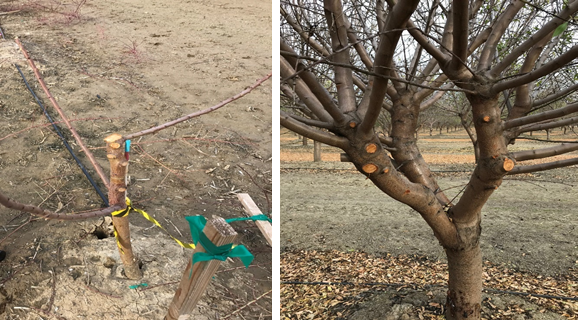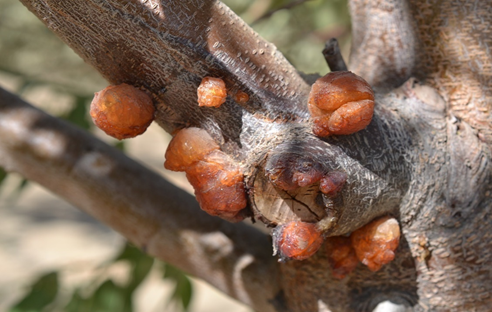Leslie Holland, PhD Candidate and Florent Trouillas, CE Specialist, UC Davis and Kearney Agricultural Research and Extension Center
As we approach winter in the Sacramento Valley and almond trees enter dormancy, pruning becomes a top priority for many growers. Whether it’s pruning for scaffold selection or to remove old, minimally productive wood to stimulate renewal of fruiting wood, pruning is often considered a dormant season practice. In California, almond dormancy overlaps with the winter months when most precipitation occurs. After a six-year drought, California experienced record-breaking rainfall in the winter and spring of 2018 and 2019. Rain events are strongly correlated with the spread of fungal canker pathogens whose primary infection sites are pruning wounds. Results from sampling over 140 almond orchards found 21 different fungal pathogens associated with these canker diseases. While the pathogens differ in biology, there are common approaches to prevent infections.
An ounce of prevention is worth a pound of cure
Most fungal pathogens that cause canker diseases are present throughout the Central Valley – so why aren’t all the trees infected? For infection to occur not only does the pathogen need to be present, but the environment (i.e. rain and temperatures) must be favorable for infection and the host must be susceptible to infection (i.e. unprotected, fresh pruning wounds). Therefore, practices that minimize conditions favoring disease development and host susceptibility are crucial.
Pruning leads to susceptibility
Pruning exposes the vascular and cambial tissues (otherwise protected by bark) that are susceptible to infection. Since these wounds require time to heal, pathogens can infect these sensitive tissues before healing is complete. Our research aimed to answer several key questions regarding pruning wound susceptibility and protection and define management guidelines for almond canker diseases.
When is the best time to prune?
We investigated the seasonal differences in infection rate for pruning wounds made in September, October, November, December, and January, respectively. Field trials were conducted in the Sacramento and San Joaquin Valleys during the dormancy period’s in 2017-18 and 2018-19. Results from these trials revealed that infection rates were lowest when pruning cuts were made in January compared to pruning cuts made in September, October and November, which had higher infection rates. While wound healing typically occurs faster in warmer weather, previous studies on almond pruning wound cankers caused by Phytophthora syringae suggested that in January, substances (ex. lignin and suberin) associated with wound healing start to increase in production after declining during November and December. It is also important to note that in the absence of rain (ex. September 2019), pruning wound exposure to fungal inoculum is significantly reduced thus risks of infection are limited.
How long are pruning wounds susceptible to infection?
During these field trials, we also studied the duration of pruning wound susceptibility to infection. Wounds that were infected with canker pathogens immediately after pruning had the highest infection rates (80-100% infection). Wounds infected two weeks after pruning, showed infection rates decreased by 60% and after three weeks infection rates decreased by 75%. As time after pruning increased, wound susceptibility to infection decreased. After 8 weeks, infection rates decreased by 85-90% overall. Regardless of when pruning occurred, fresh wounds were the most susceptible to infection.

Left: Pruning wounds left after scaffold selection on 1st leaf almond tree. Right: Pruning wounds on the main scaffolds of a mature tree. (photos: Leslie Holland)
What products can protect pruning wounds from infection?
From 2016-2018, eight field trials were conducted to assess the efficacy of 26 different pruning wound protection products. These products included fungicides spanning various FRAC groups and premixtures, biocontrols, paint, and wound sealants. Findings suggested that Topsin M (thiophanate-methyl) provides excellent control in protecting pruning wounds, reducing infection by 82% overall. A biological control product consisting of the fungus Trichoderma atroviride was also highly effective, reducing infection by 77% overall. Currently, this biological control product is being considered for registration as a pruning wound protectant against almond canker diseases in California. The performance of acrylic paint was inconsistent, and overall only reduced canker pathogen infection by 45%. Topsin M has a 2(ee) recommendation for use as pruning wound protectant on almonds in California. Conventional fungicides may be applied at the label rates with an air blast sprayer, ensuring complete coverage of pruning wounds.
Management Guidelines: Almond Canker Diseases
- Avoid pruning prior to predictions of a rain event
- Ensure proper scaffold selection to limit crack formation at the tree crotch (ex. scaffolds aren’t all coming out of the same plane).
- Pruning in January followed by immediate application of a pruning wound protection product (ex. Topsin M)
But what about orchards with established canker diseases…
While labor-intensive and time-consuming, remedial surgeries or removal of dead or diseased branches can be performed to remove infected tissues. This practice requires making sure to cut several inches into the healthy wood to remove all the infected parts. For Ceratocystis cankers, clean up the area around the infected tissue by removing loosened bark and exposing the cambium to promote callusing (a wound healing response). Diseased or dying limbs should be removed as early as the infections are detected to avoid further spread of the disease into the trunk. Of course, all pruning creates a potential entry point for canker disease fungi and the same rainfall avoidance and wound protection care made with other pruning activities should be followed with removal of dead or diseased branches.



Leave a Reply